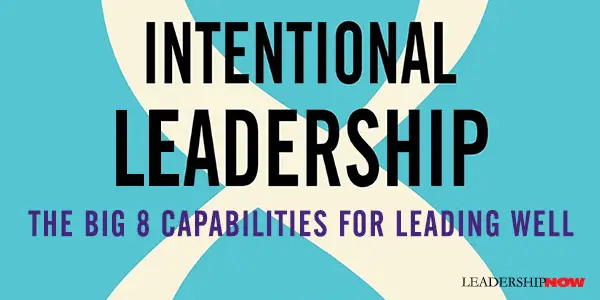 |
 |
01.24.23

Intentional Leadership: The Big 8 Capabilities for Leading Well
THE context of leadership has changed. It is more complex, and values that must be addressed have shifted. What we once glossed over now requires our attention and action. Mostly it requires that we be more intentional about relationships. Rose Patten puts it this way in Intentional Leadership: “The spotlight on leadership has moved to how people lead in challenging and changing circumstances. Innovative models, digitalization, technologies—these are all important. But what matters more is how leaders lead other people.” Good leadership happens when someone, by intention, has a positive impact—whether through empathy, inspiration, or wisdom. While some people seem to do this naturally, most of us—if we have the will—can learn it and continue to do it better. We must begin with our mindset. Our mindsets have consequences. This is where we begin to improve our influence and impact. Patten identifies four common beliefs that impede our success as a leader:
If these false beliefs are part of our mindset, then we will not take the steps necessary to respond to our leadership environment with the renewed capabilities that are required of us. They can become blind spots—unspoken beliefs that control our behavior—that, on a conscious level, we would never admit to. So, there is a need to examine ourselves to see where our behaviors don’t line up with what we say we believe. Leaders are dependent upon, and guided by, their own individual level of self-awareness, gained from self-reflection and feedback from others. This enables them to take deliberate, intentional action to check and adjust their mindset. The Big 8 The Big 8 capabilities have been created to address the needs of the changing leadership environment and to counter the false beliefs that can creep into our thinking. A healthy self-awareness is the sine qua non for all of the Big 8. They are not a definitive list of desired traits but a roadmap to self-reflection and intentional renewal for the leadership context we face today. It does not address all the skills that leaders are expected to have. Rather, the Big 8 offers the solution for leaders to become more effective and better balanced in their leading.
The Big 8 #1: Personal Adaptability Adaptability is the capacity that matters most. “Adaptability, open-mindedness, and renewal are overlapping, one leading to another. Open-mindedness enables adaptability to occur; with adaptability, the hope of renewal is possible.” It is what it means to be a lifelong learner. Adaptability requires accepting diverse views and the willingness to be uncomfortable. The Big 8 #2: Strategic Agility In a consistently changing environment, strategies are short-lived. Success depends on commitment and our ability to be adaptable and creative. It is a mindset issue. Can we adapt to the “reality that strategies do have a shelf life no matter how successful they were in the past?” The leader needs the mindset of what Patten calls the three A’s: Appraising constantly, adjusting courageously, and acting urgently. “The leader needs strategic agility, beginning with personal adaptability and overlaid with critical thinking.” The Big 8 #3: Self-Renewal Teachability—discovering what you do not know. Arrogance leads to regret. Patten reflects, “In my own leadership experiences, learning does come from mistakes and from admitting to not having all the answers. Becoming teachable and open and being around other great insightful people, including mentors, has helped me tremendously. Having a need to know things and a continuing curiosity also feed teachability. Whether it comes from innate curiosity or through intentionality – either is welcome and impactful in becoming a better leader.” The Big 8 #4: Certainty of Character “Character is not a victim of circumstances; it survives in spite of them.” Character is doing the right thing in spite of circumstances. Patten offers five checks to guide leaders: Keeping your word (Integrity), Looking to self for cause (Responsibility), Sticking your neck out (Courage), Letting go of others’ mistakes (Forgiveness), and Putting self in others’ shoes (Empathy). The Big 8 #5: Empathy Quite naturally, empathy helps you to connect with others. Not only understanding others but understanding your impact on them—putting yourself in their shoes. It allows you to adjust your behavior to the situation. The Big 8 #6: Contextual Communication Leaders must explain not just the what but the why—the context. “Communicating without “the why,” without the purpose, but with just ‘the what’ doesn’t do it in today’s workforce. More than an expression of respect, communicating ‘the why’ engenders trust.” Leaders must go beyond the analytical mindset to consider emotions and understand others’ states of mind by recognizing preconceived mindsets. The Big 8 #7: Spirited Collaboration Patten calls it spirited collaboration because it enables and encourages “dissent, with the ultimate objective of arriving at a better outcome. A harmonious group of like minds becomes an echo chamber of agreement. A leader who doesn’t allow diverse opinions and ideas for improvement will perform suboptimally.” Collaboration means listening well, understanding motivations, and depersonalizing ideas. The Big 8 #8: Developing Other Leaders—Not Only Followers “Shifting the way in which we lead from command and control to connect and collaborate means that leaders move more to empowerment and distributed leadership in the workplace.” Developing leaders is not just a matter of time and experience. It is more than just teaching technical skills. A development approach of 70-20-10 is recommended: 70% is real-time apprentice-like learning, 20% is mentoring, and 10% is classroom-type resources. 
Posted by Michael McKinney at 10:43 AM
|
BUILD YOUR KNOWLEDGE
 

How to Do Your Start-Up Right STRAIGHT TALK FOR START-UPS 
Grow Your Leadership Skills NEW AND UPCOMING LEADERSHIP BOOKS 
Leadership Minute BITE-SIZE CONCEPTS YOU CAN CHEW ON 
Classic Leadership Books BOOKS TO READ BEFORE YOU LEAD |